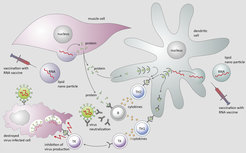“We are fortunate that the pathogen is very well attackable through vaccine immunity”
Mr. Kaufmann, the EU has now approved three vaccines against Covid-19. The first people have been vaccinated. Would you have imagined this a year ago?
Stefan Kaufmann: When the Covid-19 crisis began a year ago, I could not have imagined that three vaccines would be approved within ten or twelve months and that people would even be vaccinated already. That is a tremendous development, vaccine development has never happened so quickly.

The vaccines now approved were developed, tested, and approved within one year. That is much faster than previous vaccines, for which this took twelve years or even longer. How come it happened so quickly now?
Four aspects are relevant for a vaccine to enter development and clinical testing: First, there must be a great demand. Second, if there is a demand, it needs financial interest in supporting research and development, because vaccine development is expensive. Third, we need to know something about the pathogen. And fourth, the pathogen has to be readily tangible by vaccine-induced immunity.
Almost all of this was a given with the corona vaccines: The demand was huge, the funding was huge, there was prior knowledge through SARS and MERS, and then we were lucky that the pathogen is well tangible through vaccine immunity: Antibodies can block the virus, and their production can be triggered well by vaccination. This is different for vaccinations against major epidemics such as tuberculosis, AIDS, or malaria.
The first vaccines approved in the EU – those from Biontech/Pfizer and Moderna – are based on mRNA, that is: nucleic acid. What is special about this type of vaccine?
With RNA vaccines, neither an inactivated pathogen is injected, nor an antigen – that is, the protein that stimulates the immune response. Instead, the information for the antigen is administered, the nucleic acid. The body’s cells then produce the antigen according to the information. This type of vaccine is brand new, but experience was available from research on cancer therapy. If the immunity induced by RNA vaccines provides sufficient protection, as is the case with Covid-19, then these vaccines have numerous advantages. They can be produced very quickly, and it is technically simple to adapt them to mutations of the pathogen.

And despite new technology, development, and approval, are the new vaccines safe?
Yes, this is a new technology. However, the nanoparticles the RNA is packaged in have been used before, and there is hardly anything to worry about with RNA in terms of side effects. The RNA is rapidly degraded in the body once it has done its job. Furthermore, this nucleic acid cannot be incorporated into our genome because the human body lacks the ability to transcribe RNA into DNA. Therefore, RNA vaccines are conceptually very safe.
The clinical trials have focused on safety right up to the end, in phase III. However, very few people are allergic to one of the nanoparticles’ components. That is polyethylene glycol. This was discovered in the studies, so we were prepared for it. The approval process was extraordinarily fast. But nothing was overlooked, it was simply worked through as quickly as possible. I hope that this will become a model for future vaccines. Of course, we cannot completely rule out rare long-term adverse events, but we will continue to monitor and record them, and investigate possible complications.
There are several rumors circulating about the vaccines’ safety. One of them is that after vaccination, you are contagious yourself for a few days, as can be the case with a measles vaccination.
An RNA vaccine cannot be contagious, that is for sure. This is true for almost all vaccines, with only very few exceptions. These are possibly attenuated live vaccines such as the one against measles or the oral polio vaccine.
“We need to have 85 percent immunity or even higher to achieve herd immunity.”
According to another rumor, the vaccine may make women infertile because it is said to contain the protein syncytin, which is also produced by the embryo.
I believe this claim is simply false. Syncytin-1 is a protein that is produced in the placenta. The corona spike protein contains a short sequence of five amino acids (the building blocks of proteins) which shows some similarity with syncytin-1. This is a very weak similarity, because the entire spike protein consists of over 1,200 amino acids and the entire syncytin-1 of over 500. Furthermore, there is no evidence that natural infections with SARS-CoV-2, in which the spike protein also induces immunity, cause infertility. Finally, antibodies could not reach the syncytin in the placenta all that easily as it is well hidden and shielded from antibodies.
Do vaccines protect only against the onset of disease or also against infection? In other words, can vaccinated people transmit Covid-19?
At the moment, all we know is that the vaccines provide excellent protection against disease. That is their strength, and that is what was looked at in the clinical trials. The question of whether the vaccine also protects against infection, and thus against transmission, has been deemed less important in the clinical assessment until recently.
From Israel, where a large part of the population has already been vaccinated, there is initial data on the RNA vaccine from Biontech/Pfizer that make me hopeful: There, a significant decrease in infections among those vaccinated was already observed in the first two weeks after the first vaccination, and the effect was even stronger another two weeks later. It is still not entirely clear whether people do not get infected at all or whether the virus is quickly eliminated after a short infection phase. However, we can assume that those vaccinated are less contagious, but we cannot exactly say yet whether they are contagious for a shorter time period and with lower infectivity or not at all.
Mr Kaufmann updated this answer on May 5, 2021:
In the meantime, we know that the vaccines largely prevent stable infection with SARS-CoV2 and very significantly stop transmission. We also know that the vaccines significantly mitigate at least severe Covid-19 pathogenesis caused by the mutants. There is a difference between just having a cough or fever and requiring intensive care.
How quickly can the available vaccines be adapted to mutants of the virus that could render the vaccine ineffective or weaken it?
Mutations at sites on the virus where the antibodies attack can facilitate evasion, meaning the virus cannot be controlled as effectively. Here, the RNA vaccines have a great advantage: As I said, they can be adapted very quickly. The sequence is changed according to the mutation in the pathogen and then they probably work very well again. Of course, we will then have to see to what extent clinical studies are necessary again. Since the vaccine is basically the same, I assume that so-called bridging procedures are needed, that is, only a few studies that prove that the vaccine is still effective and safe.
Based on the reproduction numbers of SARS-CoV-2 to date, at least 70 percent of the population needs to be vaccinated to achieve what is called herd immunity and to be able to control the spread of Covid-19. Will that change if more contagious variants like the British or South African mutants spread in our country?
The first thing to say is: Until we know whether vaccination also protects against infection and transmission, we have to be somewhat cautious about harnessing vaccination to achieve herd immunity. Data from Israel indicates that vaccination indeed significantly reduces spread of the virus.
And with herd immunity, the thing is: Below 70 percent you can become infected, above you cannot – it is not that simple. This depends on many factors: Among others, the infection rate of the pathogen, the survival of the pathogen in the environment, the transmission route. For an airborne pathogen like SARS-CoV-2, I assume 85 percent immunity or even higher to achieve herd immunity. This also depends on people’s behavior: The higher the mobility, the higher the threshold for herd immunity. Finally, more contagious virus variants increase this value, as well. The reverse is also true, of course: If AHA rules and major restrictions apply when interacting with others, herd immunity can be reached earlier.
Do you assume that people immunized with the new vaccines will have as high an immunity as people who have undergone Covid-19 infection?
Yes, I assume so. Maybe the immunization is even better, because the vaccination is made to trigger a quite strong immune response. And we know from experience that vaccination can be better than natural infection in terms of protection.
“The World Health Organization has identified ten threats to human health. One of them is: vaccine hesitancy.”
In parallel, many other vaccines against Corona have been developed, but they have not yet been approved. Do will still need them?
For the start, we should be more than happy with the current vaccines. On the other hand, we need billions of vaccine doses worldwide. To achieve that, we need to pursue and approve other vaccines. In addition, vaccines often work through different principles. The RNA vaccines’ protection rate against disease of 95 percent is excellent. But other vaccines might be better for certain purposes. One vaccine might work better in younger people, another better in older people. In the long term, new vaccines will become available. This might be vaccines in which other antigens have been integrated. Or inactivated vaccines, such as those being developed and used in China, which have largely the same antigen repertoire as the pathogen. The chances then increase that the viruses cannot escape the protective immune response so quickly due to mutation.
What questions about the Corona vaccines are still open for you?
There are still a lot of open questions. First, we do not yet know how long the vaccine protection will last. Ideally, of course, we would have lifelong immunity, which is unlikely. Then we do not know how broadly the vaccines will work, that is, whether or not they will protect against mutants. We do not understand their effect in specific populations: Can we successfully and safely vaccinate people with immunosuppression or certain other pre-existing conditions? Also: Will there be a vaccine that works much better when combined with another?
One last question. What needs to be done to increase the readiness to get vaccinated?
In 2019, the World Health Organization has identified ten threats to human health. One of them is: vaccine hesitancy. This can have various reasons. First, there are people who do not have full confidence in vaccines and may have been misinformed – I call them vaccine doubters. Second, there are vaccine skeptics who raise questions. They may have a good argument now and then, but by and large the arguments are not valid. Here, it can be worthwhile to talk to them and convince them. And third, there are ‘anti-vaxxers’ who believe in and spread fake news. In extreme cases, they may even believe in conspiracy theories. Unfortunately, it is difficult to do something about this.
Overall, much more can be done to convince people that the benefits of vaccination outweigh the risks. You have to communicate this comparison: On the one hand, there is a risk of vaccination that is extraordinarily low. On the other hand, there is the risk of falling ill and possibly dying. Numerous studies have shown that, in Europe, confidence in the safety of vaccines is lower than confidence in their effectiveness. Meaning that people are more likely to believe that a vaccine works than that it is safe.
Mr. Kaufmann, thank you very much for talking to us.
The questions were asked by Frederik Köpper

